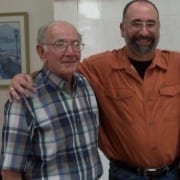Coming Home
By Lance Allen Wang, Editor
This month’s issue is dedicated to the theme “Coming Home,” an important aspect of the wartime experience. It is sometimes an occasion for celebration. It is also sometimes its own devastating crucible. I had the distinct honor and privilege of writing the Foreword to a book about my Uncle Julie’s experiences as a World War II B-17 navigator, “One of Thousands” (Lulu Publishing, 2015). I recounted my experiences growing up in awe of this man, and he was perhaps the most important influence in my donning the uniform. But I closed with these lines:
“… But equally, what I wanted to know from him coming home from Iraq was how to be a war vet. Things change. Perspectives change. How do you wear something so much larger than yourself, those moments of fear, those moments of boredom in a foreign land, those ‘crowded hours,’ and incorporate them into who you are? Perhaps I expected more of Uncle Julie in this regard than he could provide. What did Uncle Julie do with his experiences of Europe? Where does it all go?”
No one teaches you how to be a veteran. My experience with redeployment programs found far more “check the block” than anything else (now, granted, things may have changed in the nearly 10 years since I left the Army). They were simply mundane briefings to bored, fidgety soldiers who just wanted to go home. Back in my Uncle Julie’s time, the decompression of redeployment was eased in some ways by extended journeys home on troop ships. The culture shock of Vietnam veterans – “Two days before I was in Vietnam – then all of the sudden I was in a college classroom,” as one vet described it to me – was eased for World War II veterans by the shared experience of being on a troop ship with your comrades. Technological progress in transportation created its own set of problems.
Part of my coming home was eased by my search for historical perspective on coming home. Actually, the interviews that resulted in the book “One of Thousands” was part of that search – I’d developed my rapport anew with my Uncle while I was overseas. He began a correspondence with me, drawing the parallels between the experiences I wrote about overseas with his own when he was stationed in Nuthampstead, England, home of his 602nd Squadron, 398th Bomb Group (Heavy).
My search for perspective was also to view the 1946 Best Picture winner, “The Best Years of Our Lives,” which I still consider one of the best pictures about returning service members and the new battles which begin when the uniform comes off. Prior to this film, much of the return of the veteran was captured for the public in the famous idealized Saturday Evening Post Norman Rockwell covers such as 1919’s “When Johnny Comes Marching Home” and 1945’s “Homecoming GI” and “Homecoming Marine.” “The Best Years of our Lives” was based on a book about returning service members which was actually written as an extended poem because the author felt that he couldn’t capture the topic in mere prose. And the movie, which was brutal in its depiction of what the returnees faced, actually was cleaned up in some ways – the book showed the veteran Homer, who is missing his hands following the torpedoing of his ship in the Navy, as actually suffering from nervous spasticity.
The movie broke a number of taboos – it was the first to show alcoholism, infidelity, “combat fatigue” (as PTSD was known at the time), and those on the home front who profited from the war. It showed veterans denied loans, and it showed civilians who called those who fought “suckers.” It showed strained and broken marriages. It showed the complete incompatibility of the wartime experience with “polite society.”
It is important to note that this movie takes place in the context of America’s first “total war” – with full mobilization of the nation’s industrial might and civilian population to support the war. While there is a disconnect between the service member’s experience and that of the general population, it is not a complete disconnect. Today’s wars, which are fought by a volunteer military made up of an insignificant proportion of the population, sadly results in a far more complete disconnect. It is that disconnect which makes the struggle of the post-World War II veteran even more severe.
This makes the role of Veteran Service Organizations such as Jewish War Veterans more important in order to help the returnee find others with whom to share the burden of coming home, and it is incumbent on us to continue our outreach to our war veteran brothers and sisters, and continue to find more effective ways of doing so.
Volume 72. Number 2. Summer 2018





Leave a Reply
Want to join the discussion?Feel free to contribute!